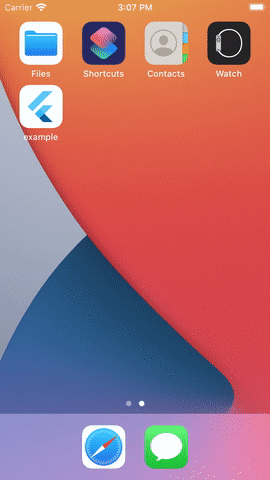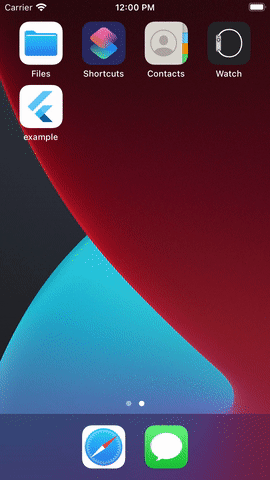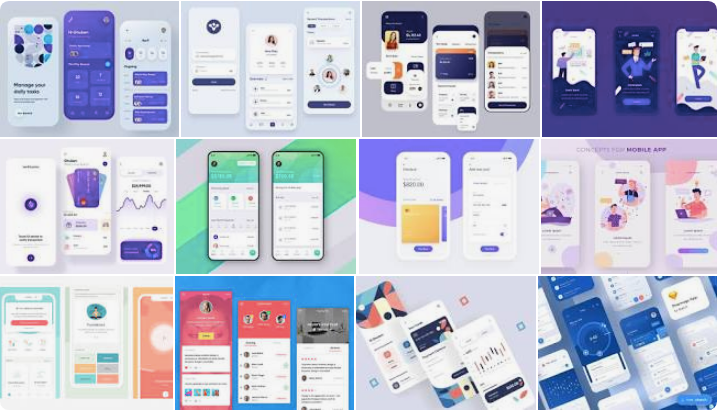When your app is opened, there is a brief time while the native app loads Flutter. By default, during this time the native app displays a white splash screen. This package automatically generates iOS, Android, and Web native code for customizing this native splash screen background color and splash image. Supports dark mode, full screen, and platform-specific options.


Usage
Would you prefer a video tutorial instead? Check out Johannes Milke’s tutorial.
First, add flutter_native_splash as a dev dependency in your pubspec.yaml file. It belongs in dev_dependencies because it is a command line tool.
dev_dependencies: flutter_native_splash: ^1.1.8+4
Don’t forget to flutter pub get.
NOTE:
If you are using Flutter 1.x (no null safety), you must use the 0.x version of this package.
1. Setting the splash screen
Customized the following settings and add to your project’s pubspec.yaml file or place in a new file in your root project folder named flutter_native_splash.yaml.
flutter_native_splash: # This package generates native code to customize Flutter's default white native splash screen # with background color and splash image. # Customize the parameters below, and run the following command in the terminal: # flutter pub run flutter_native_splash:create # To restore Flutter's default white splash screen, run the following command in the terminal: # flutter pub run flutter_native_splash:remove # color or background_image is the only required parameter. Use color to set the background # of your splash screen to a solid color. Use background_image to set the background of your # splash screen to a png image. This is useful for gradients. The image will be stretch to the # size of the app. Only one parameter can be used, color and background_image cannot both be set. color: "#42a5f5" #background_image: "assets/background.png" # Optional parameters are listed below. To enable a parameter, uncomment the line by removing # the leading # character. # The image parameter allows you to specify an image used in the splash screen. It must be a # png file. #image: assets/splash.png # The color_dark, background_image_dark, and image_dark are parameters that set the background # and image when the device is in dark mode. If they are not specified, the app will use the # parameters from above. If the image_dark parameter is specified, color_dark or # background_image_dark must be specified. color_dark and background_image_dark cannot both be # set. #color_dark: "#042a49" #background_image_dark: "assets/dark-background.png" #image_dark: assets/splash-invert.png # The android, ios and web parameters can be used to disable generating a splash screen on a given # platform. #android: false #ios: false #web: false # The position of the splash image can be set with android_gravity, ios_content_mode, and # web_image_mode parameters. All default to center. # # android_gravity can be one of the following Android Gravity (see # https://developer.android.com/reference/android/view/Gravity): bottom, center, # center_horizontal, center_vertical, clip_horizontal, clip_vertical, end, fill, fill_horizontal, # fill_vertical, left, right, start, or top. #android_gravity: center # # ios_content_mode can be one of the following iOS UIView.ContentMode (see # https://developer.apple.com/documentation/uikit/uiview/contentmode): scaleToFill, # scaleAspectFit, scaleAspectFill, center, top, bottom, left, right, topLeft, topRight, # bottomLeft, or bottomRight. #ios_content_mode: center # # web_image_mode can be one of the following modes: center, contain, stretch, and cover. #web_image_mode: center # To hide the notification bar, use the fullscreen parameter. Has no affect in web since web # has no notification bar. Defaults to false. # NOTE: Unlike Android, iOS will not automatically show the notification bar when the app loads. # To show the notification bar, add the following code to your Flutter app: # WidgetsFlutterBinding.ensureInitialized(); # SystemChrome.setEnabledSystemUIOverlays([SystemUiOverlay.bottom, SystemUiOverlay.top]); #fullscreen: true # If you have changed the name(s) of your info.plist file(s), you can specify the filename(s) # with the info_plist_files parameter. Remove only the # characters in the three lines below, # do not remove any spaces: #info_plist_files: # - 'ios/Runner/Info-Debug.plist' # - 'ios/Runner/Info-Release.plist'
2. Run the package
After adding your settings, run the following command in the terminal:
flutter pub run flutter_native_splash:createWhen the package finishes running, your splash screen is ready.
Beta support for Android 12
Android 12 has a new method of adding splash screens, which consists of specifying the window background, animated app icon, and the icon background. Android 12 also supports legacy splash screens as they have been implemented in Flutter and this package. At this time, this package will provide beta support for Android 12 with a legacy implementation.
To enable Android 12 support, set up the Android 12 SDK, add android12: true to your configuration, and run the package:
flutter pub run flutter_native_splash:create
The package will add a styles.xml in values-v31 and values-night-v31 resource folders, which will allow Android 12 to maintain the legacy splash screen.
This package will add support for the new Android 12 splash screens in the future. However, I will wait to see how Flutter adapts to the new splash screen format so that this package can complement Flutter’s implementation and avoid reinventing the wheel.
At this time, the splash screen may jump when using fullscreen with Android 12.
Recommendations
Secondary splash screen:
The native splash screen is displayed while the native app loads the Flutter framework. Once Flutter loads, there may still be resources that need to be loaded before your app is ready. For this reason, you should consider implementing a Flutter splash screen that is displayed while these resources load. Here is a code example of a secondary Flutter splash screen, or use a package from pub.dev.
class MyApp extends StatelessWidget {
@override
Widget build(BuildContext context) {
return FutureBuilder(
// Replace the 3 second delay with your initialization code:
future: Future.delayed(Duration(seconds: 3)),
builder: (context, AsyncSnapshot snapshot) {
// Show splash screen while waiting for app resources to load:
if (snapshot.connectionState == ConnectionState.waiting) {
return MaterialApp(home: Splash());
} else {
// Loading is done, return the app:
return MaterialApp(
home: Scaffold(body: Center(child: Text('App loaded'))),
);
}
},
);
}
}
class Splash extends StatelessWidget {
@override
Widget build(BuildContext context) {
return Scaffold(
body: Center(
child: Icon(
Icons.apartment_outlined,
size: MediaQuery.of(context).size.width * 0.785,
),
),
);
}
}
Material resources:
- If you want to use a Material Icon as your splash image, download an icon in (material.io/resources/icons) as PNG for Android. I recommend using the biggest icon in
drawable-xxxhdpifolder which was just downloaded for better results. - Material Colors are available in material.io/resources/color
FAQs
I got the error “A splash screen was provided to Flutter, but this is deprecated.”
This message is not related to this package but is related to a change in how Flutter handles splash screens in Flutter 2.5. It is caused by having the following code in your AndroidManifest.xml, which was included by default in previous versions of Flutter:
<meta-data android:name="io.flutter.embedding.android.SplashScreenDrawable" android:resource="@drawable/launch_background" />
The solution is to remove the above code.
Can I change the duration of the splash screen?
The native splash screen is displayed while the native app loads the Flutter framework. Because the resources in your app cannot load while the native splash screen is displayed, the native splash screen must be as fast as possible. Note that delaying the user experience is a poor design decision.
Are animations/lottie/GIF images supported?
Not at this time. However, you may want to consider a secondary splash screen that supports animation. See the secondary splash screen recommendation.
I got the error AAPT: error: style attribute ‘android:attr/windowSplashScreenBackground’ not found
This attribute is only found in Android 12, so if you are getting this error, it means your project is not fully set up for Android 12. Did you update your app’s build configuration?
I see a white screen between splash screen and app
- It may be caused by an iOS splash caching bug, which can be solved by uninstalling your app, powering off your device, power back on, and then try reinstalling.
- It may be caused by the delay due to initialization in your app. To test this, make a test where your
main()returns aContainer(color: Colors.black);. If the white flash goes away, it will show that your content is not loading fast enough. You could solve this by creating a secondary splash screen or loading a barebones version of your app with placeholders, and then populate the placeholders as content loads.
Notes
- If splash screen was not updated properly on iOS or if you experience a white screen before splash screen, run
flutter cleanand recompile your app. If that does not solve the problem, delete your app from the device, power down the device, power up device, install and launch app as per this stackoverflow thread. - This package modifies
launch_background.xmlandstyles.xmlfiles on Android,LaunchScreen.storyboardandInfo.pliston iOS, andindex.htmlon Web. If you have modified these files manually, this plugin may not work properly. Please open an issue if you find any bugs.
How it works
Android
- Your splash image will be resized to
mdpi,hdpi,xhdpi,xxhdpiandxxxhdpidrawables. - An
<item>tag containing a<bitmap>for your splash image drawable will be added inlaunch_background.xml - Background color will be added in
colors.xmland referenced inlaunch_background.xml. - Code for full screen mode toggle will be added in
styles.xml. - Dark mode variants are placed in
drawable-night,values-night, etc. resource folders.
iOS
- Your splash image will be resized to
@3xand@2ximages. - Color and image properties will be inserted in
LaunchScreen.storyboard. - The background color is implemented by using a single pixel png file and stretching it to fit the screen.
- Code for hidden status bar toggle will be added in
Info.plist.
Web
- A
web/splashfolder will be created for splash screen images and CSS files. - Your splash image will be resized to
1x,2x, and3xsizes and placed inweb/splash/img. - The splash style sheet will be added to the app’s
web/index.html, as well as the HTML for the splash pictures.
Removing
If you would like to restore Flutter’s default white splash screen, run the following command in the terminal:
flutter pub run flutter_native_splash:removeAcknowledgments
This package was originally created by Henrique Arthur and it is currently maintained by Jon Hanson.
Bugs or Requests
If you encounter any problems feel free to open an issue. If you feel the library is missing a feature, please raise a ticket. Pull request are also welcome.
Download native code for adding splash screens source code on GitHub
https://github.com/jonbhanson/flutter_native_splash
Check our more implementatio guide on pub.dev
https://pub.dev/packages/flutter_native_splash
Provides the list of the opensource Flutter apps collection with GitHub repository.

